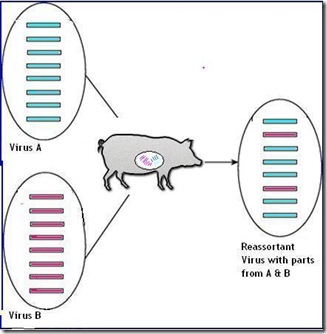# 6621
The only thing truly constant with influenza viruses is that they are continually changing. As flu viruses leave behind varying levels of immunity in those they infect - were they not to change over time - they would soon die out due to a lack of susceptible hosts.
Influenza viruses evolve via two well established routes; Antigenic drift and Antigenic Shift (reassortment).
Antigenic drift causes small, incremental changes in the virus over time. Drift is the standard evolutionary process of influenza viruses, and often come about due to replication errors that are common with single-strand RNA viruses.
Shift occurs when one virus swap out chunks of their genetic code with gene segments from another virus. This is known as reassortment. While far less common than drift, shift can produce abrupt, dramatic, and sometimes pandemic inducing changes to the virus.
For shift to happen, a host (human, swine, bird) must be infected by two influenza different viruses at the same time.

Reassortment of two Flu viruses
While successful reassortment is relatively rare, as any virologist will tell you . . . Shift happens.
While we talk about four main strains of influenza that currently circulate in humans (A/H1N1(pdm), A/H3N2, B Victoria, B Yamagata), in reality – within each strain - you will find a good deal of diversity.
New `prototypes’ from these strains are constantly being generated and are then immediately`field tested’ for biological fitness and transmissibility.
Most fail miserably.
But occasionally, a new, biologically fit virus will emerge that can outcompete its parental strains, and it begins to spread rapidly.
Since flu vaccine formulations must be decided upon six months before they can be deployed, public health agencies like the CDC, ECDC, Hong Kong’s CHP (and others) spend considerable resources on influenza surveillance, looking for signs of any up-and-coming viral strains.
Once each month the ECDC issues an influenza characterization report, showing what changes have been detected in the influenza viruses circulating in Europe.
Below you’ll find a link to their recent report, and a brief summary of the highlights.
Influenza virus characterisation - Summary Europe, September 2012
ABSTRACT
Since 01 January 2012, influenza A(H1N1)pdm09, influenza A(H3N2) and influenza B/Victoria and B/Yamagata lineage viruses have been detected in ECDC-affiliated countries.
- Type A viruses have predominated over type B.
- A(H3N2) viruses have predominated over A(H1N1)pdm09 viruses.
- A(H1N1)pdm09 viruses continue to show genetic drift from the vaccine virus, A/California/07/2009, but the vast majority remain antigenically similar to it.
- During the last nine months, all European A(H3N2) viruses sequenced fell within five genetic clusters. Test viruses isolated in mammalian cells show low titres with post-infection ferret antisera raised against egg-propagated viruses, including the new vaccine virus A/Victoria/361/2011. They react well with post-infection ferret antisera raised against A/Victoria/361/2011 and other current reference viruses propagated exclusively in tissue culture.
- Recent B/Victoria lineage viruses fell within the B/Brisbane/60/2008 genetic clade and were antigenically similar to reference cell-propagated viruses of the B/Brisbane/60/2008 genetic clade.
- Recent B/Yamagata-lineage viruses fell into two genetic clades, represented by the recommended vaccine component for the 2012/2013 influenza season, B/Wisconsin/1/2010 (clade 3), or B/Estonia/55669/2012 (clade 2); viruses in these clades are antigenically distinguishable.
- Antigenic analyses of A(H3N2)v viruses, the cause of zoonotic infections in the USA, indicate that these viruses are antigenically distinct from seasonal A(H3N2) viruses.
The best news in this report is that most of the newest iterations of the (now seasonal) 2009 pandemic H1N1 virus continue to be antigenically similar to the original virus, and this year’s vaccine should be reasonably effective against it.
As for the growing diversity and antigenic drift among the A/H3N2 viruses (now 5 distinct subtypes), we’ll have to wait to see how much of an impact they will have on the overall VE (Vaccine Effectiveness) of this year’s flu vaccine.
We are also seeing signs of divergence in the Yamagata lineage between this year’s vaccine component clade 3 virus (B/Wisconsin/1/2010) virus and a newer clade 2 virus (B/Estonia/55669/2012).
Despite the inevitable diversity being reported in flu viruses across Europe, the World Health Organization recently released their Southern Hemisphere 2013 Flu Vaccine Composition recommendations, which remain unchanged from this fall’s vaccine.
Which is a pretty good indication that their confidence in the makeup of this fall’s flu vaccine remains high.